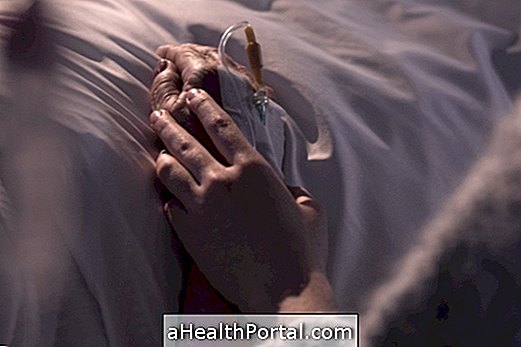Brain death and coma are two very different but clinically important conditions, which can usually arise after serious trauma to the brain, such as after a major accident, high altitude fall, stroke, tumors or overdose, for example.
Although coma can progress to brain death, they are usually very different phases and they differently affect a person's recovery. In brain death there is a definitive loss of brain functions, and therefore recovery is not possible. The coma is a situation in which the patient maintains some level of brain activity, which can be detected in an electroencephalogram, and there is hope of recovery.
1. What is coma?

Coma is a state of profound loss of consciousness in which the person does not wake up, but the brain continues to produce electrical signals that spread throughout the body and maintain the most basic and important systems for survival, such as respiration or the response of eyes to light, for example.
Often, the coma is reversible and therefore the person can re-awaken, however, the time until the coma pass state is very variable, according to age, general health status and cause. There are even situations in which coma is induced by physicians to increase the speed of recovery of the patient, as in cases of severe head trauma.
A person who is in a coma is considered legally alive, regardless of the severity or duration of that state.
What happens when the person is in a coma
When a person is in a coma, they need to be on breathing apparatus and constantly monitor their circulation, urine and feces. The feeding is done through probes because the person does not sketch any reaction and therefore needs to stay in the hospital or at home, needing constant care.
2. What is brain death

Brain death occurs when there is no longer any electrical activity in the brain, although the heart continues to beat and the body can be kept alive with an artificial respirator and feeding directly through the vein.
Can the brain-dead person wake up again?
The cases of brain death are irreversible and, therefore, unlike the coma, the person can no longer wake up again. For this reason, a person's brain death is considered legally dead and appliances that keep the body alive can be turned off, especially if they are needed for other cases where there is a chance of success.
How Brain Death Is Confirmed
Brain death needs to be confirmed by a physician after evaluation of various types of involuntary body responses that assess the presence of brain activity. Thus, a person is considered brain dead when:
- Does not respond to simple commands such as "open your eyes", "close your hand" or "move a finger";
- The arms and legs do not react when they are moved;
- The pupils do not change size with the presence of light;
- The eyes do not close when you touch the eye;
- There is no reflex of vomiting;
- One is not able to breathe without the help of machines.
In addition, other tests, such as an electroencephalogram, can be done to make sure there is no electrical activity in the brain.
What to do in case of brain death
Upon receiving the news that the patient is in brain death doctors usually question the direct family of the victim if they authorize the donation of organs, as long as they are healthy and able to save other lives.
Some organs that can be donated in case of brain death are heart, kidneys, liver, lungs and the cornea of the eyes, for example. As there are many patients waiting in line to receive an organ, the patient's brain-dead bodies can contribute to the treatment and even save the life of another person in less than 24 hours.

























